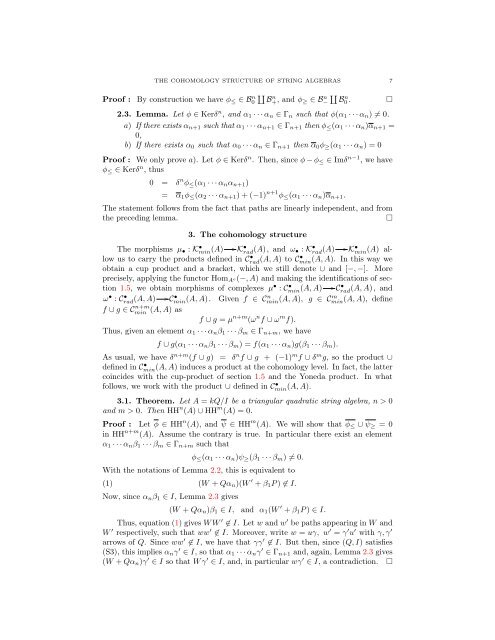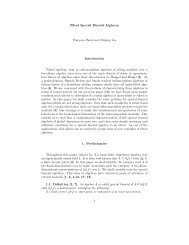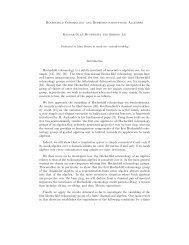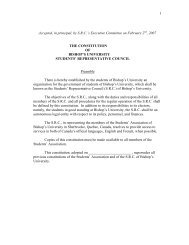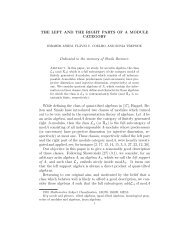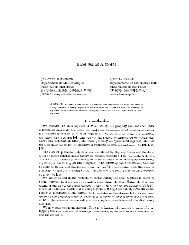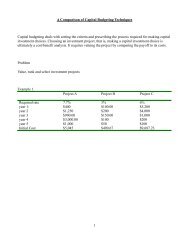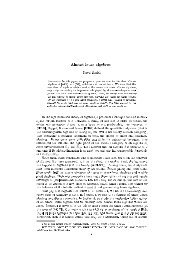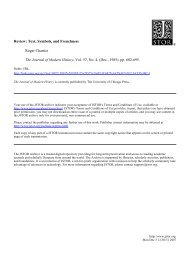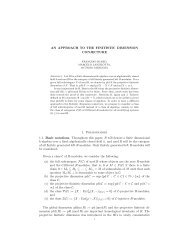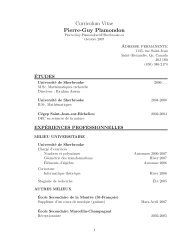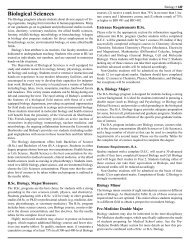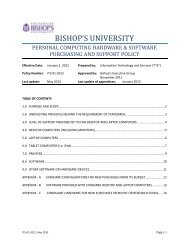The cohomology structure of string algebras
The cohomology structure of string algebras
The cohomology structure of string algebras
Create successful ePaper yourself
Turn your PDF publications into a flip-book with our unique Google optimized e-Paper software.
THE COHOMOLOGY STRUCTURE OF STRING ALGEBRAS 7<br />
Pro<strong>of</strong> : By construction we have φ ≤ ∈ B n 0<br />
∐ B<br />
n<br />
+ , and φ ≥ ∈ B n −<br />
∐ B<br />
n<br />
0 . □<br />
2.3. Lemma. Let φ ∈ Kerδ n , and α 1 · · · α n ∈ Γ n such that φ(α 1 · · · α n ) ≠ 0.<br />
a) If there exists α n+1 such that α 1 · · · α n+1 ∈ Γ n+1 then φ ≤ (α 1 · · · α n )α n+1 =<br />
0,<br />
b) If there exists α 0 such that α 0 · · · α n ∈ Γ n+1 then α 0 φ ≥ (α 1 · · · α n ) = 0<br />
Pro<strong>of</strong> : We only prove a). Let φ ∈ Kerδ n . <strong>The</strong>n, since φ − φ ≤ ∈ Imδ n−1 , we have<br />
φ ≤ ∈ Kerδ n , thus<br />
0 = δ n φ ≤ (α 1 · · · α n α n+1 )<br />
= α 1 φ ≤ (α 2 · · · α n+1 ) + (−1) n+1 φ ≤ (α 1 · · · α n )α n+1 .<br />
<strong>The</strong> statement follows from the fact that paths are linearly independent, and from<br />
the preceding lemma.<br />
□<br />
3. <strong>The</strong> <strong>cohomology</strong> <strong>structure</strong><br />
<strong>The</strong> morphisms µ • : K min • (A) K<br />
rad • (A), and ω • : K<br />
rad • (A) K min • (A) allow<br />
us to carry the products defined in C<br />
rad • (A, A) to C• min (A, A). In this way we<br />
obtain a cup product and a bracket, which we still denote ∪ and [−, −]. More<br />
precisely, applying the functor Hom A e(−, A) and making the identifications <strong>of</strong> section<br />
1.5, we obtain morphisms <strong>of</strong> complexes µ • : C min • (A, A) C<br />
rad • (A, A), and<br />
ω • : C<br />
rad • (A, A) C min • (A, A). Given f ∈ Cn min (A, A), g ∈ Cm min (A, A), define<br />
f ∪ g ∈ C n+m<br />
min (A, A) as<br />
f ∪ g = µ n+m (ω n f ∪ ω m f).<br />
Thus, given an element α 1 · · · α n β 1 · · · β m ∈ Γ n+m , we have<br />
f ∪ g(α 1 · · · α n β 1 · · · β m ) = f(α 1 · · · α n )g(β 1 · · · β m ).<br />
As usual, we have δ n+m (f ∪ g) = δ n f ∪ g + (−1) m f ∪ δ m g, so the product ∪<br />
defined in C min • (A, A) induces a product at the <strong>cohomology</strong> level. In fact, the latter<br />
coincides with the cup-product <strong>of</strong> section 1.5 and the Yoneda product. In what<br />
follows, we work with the product ∪ defined in C min • (A, A).<br />
3.1. <strong>The</strong>orem. Let A = kQ/I be a triangular quadratic <strong>string</strong> algebra, n > 0<br />
and m > 0. <strong>The</strong>n HH n (A) ∪ HH m (A) = 0.<br />
Pro<strong>of</strong> : Let φ ∈ HH n (A), and ψ ∈ HH m (A). We will show that φ ≤ ∪ ψ ≥ = 0<br />
in HH n+m (A). Assume the contrary is true. In particular there exist an element<br />
α 1 · · · α n β 1 · · · β m ∈ Γ n+m such that<br />
φ ≤ (α 1 · · · α n )ψ ≥ (β 1 · · · β m ) ≠ 0.<br />
With the notations <strong>of</strong> Lemma 2.2, this is equivalent to<br />
(1) (W + Qα n )(W ′ + β 1 P ) ∉ I.<br />
Now, since α n β 1 ∈ I, Lemma 2.3 gives<br />
(W + Qα n )β 1 ∈ I, and α 1 (W ′ + β 1 P ) ∈ I.<br />
Thus, equation (1) gives W W ′ ∉ I. Let w and w ′ be paths appearing in W and<br />
W ′ respectively, such that ww ′ ∉ I. Moreover, write w = uγ, w ′ = γ ′ u ′ with γ, γ ′<br />
arrows <strong>of</strong> Q. Since ww ′ ∉ I, we have that γγ ′ ∉ I. But then, since (Q, I) satisfies<br />
(S3), this implies α n γ ′ ∈ I, so that α 1 · · · α n γ ′ ∈ Γ n+1 and, again, Lemma 2.3 gives<br />
(W + Qα n )γ ′ ∈ I so that W γ ′ ∈ I, and, in particular wγ ′ ∈ I, a contradiction. □


